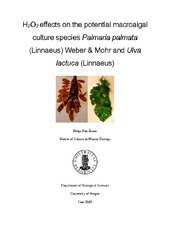H2O2 effects on the potential macroalgal culture species Palmaria palmata (Linnaeus) Weber & Mohr and Ulva lactuca (Linnaeus)
Master thesis
Permanent lenke
https://hdl.handle.net/1956/20421Utgivelsesdato
2019-06-26Metadata
Vis full innførselSamlinger
- Master theses [269]
Sammendrag
Hydrogen peroxide (H2O2) has been the most used remedy against salmon sea lice (Lepeophtheirus salmonis) in Norway since 2013. This remedy has been considered environmentally friendly, because it breaks down to water and oxygen, even though it is a part of reactive oxygen species (ROS) that can cause damage to tissues and cells. Documented half-lives on several days and quick vertical dispersal leaves a time window where it can potentially harm non-target organisms, such as macroalgae. Surplus production of dissolved nutrients and organic particles is another challenge for the aquaculture industry in Norway. Multi-trophic aquaculture (IMTA) has been suggested as a solution to this problem, where the production of seaweeds is expected to be an important part of this development. A prerequisite for establishment of such facilities will be that the production of the different species can coexist without affecting each other negatively. This study has assessed how the commercially interesting red alga Palmaria palmata and green alga Ulva lactuca are responding to H2O2 exposure. The state of the photosynthetic apparatus was mapped by two different methods. The oxygen evolution was measured during increasing light levels, for both species. In addition, fluorescence lifetime and intensity measurements were taken of U. lactuca. Even though there were not always visible signs after exposure, the photosynthetic apparatus in both species were affected. U. lactuca showed a higher tolerance towards H2O2 compared to P. palmata. Concentrations equivalent to 10% and 25% of a normal treatment dose in net pens, lowered the estimated maximum photosynthetic efficiency by more than 50% for P. palmata and U. lactuca, respectively. These differences have been linked to their general tolerance towards environmental stressors and internal ROS scavenging abilities. Comparing these results with measured and estimated concentrations likely to be found in the environment, reveals a potential issue for future IMTA-facilities. Especially when considering that a prerequisite for functional IMTA-facilities is to have the algae in close proximity to the net pens.
